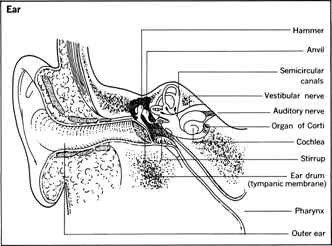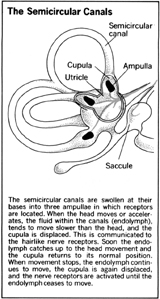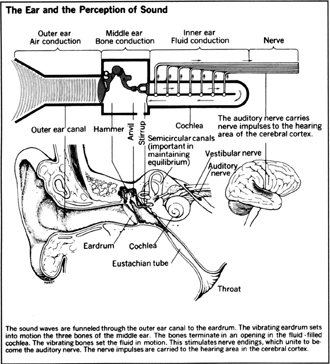The Sense Organs - The ear
Within the tunnels and chambers of the ear lie the two special types of sense receptors that give us, respectively, the sense of hearing and the sense of balance.
The Outer Ear
The outer ear includes that rather oddly shaped and folded piece of flesh and cartilage from which earrings are hung, and more important, the external auditory canal , a tunnel leading from the ear's opening to the tympanic membrane , or eardrum .
The Middle Ear
The middle ear includes the inner surface of the eardrum and the three tiny, bony ossicles , named long ago for their shape (apparently by some blacksmithing anatomist), the hammer, the anvil , and the stirrup; or in Latin: the malleus, the incus , and the stapes . These bones respond to the vibrations in the air that are the basis of sound, vibrate themselves, and transmit their vibrations to the inner ear, where the sense receptors for hearing are located, and the auditory (or acoustic ) nerve to the brain begins.

The middle ear is connected to the back of the throat (pharynx) by the Eustachian tube. This tunnel between throat and middle ear makes the pressure on the inside of the eardrum, via the mouth, the same as the pressure of the atmosphere on the outside of the eardrum. (Thus yawning helps to equalize pressure.) Without it, or if the Eustachian tube becomes clogged, the taut membrane of the eardrum would always be in imminent danger of bursting.
The Inner Ear
The chambers of the inner ear are completely filled with fluid, which is jostled by the ossicles “knocking” on a thin membrane called the oval window, separating the middle from the inner ear. Another flexible membrane, the round window, serves to restrict the motion of the inner ear fluid when the movement is too stormy.
Organ of Hearing
Within the inner ear is a bony structure coiled like a snail shell about the size of a pea. This is the cochlea , the actual Latin word for snail or snail shell. Following the internal spiral of the cochlea is the organ of Corti , the true sense receptors for hearing.
The organ of Corti is made up of thousands of specialized nerve endings that are the individual sense receptors for sound. These are in the form of tiny hairs projecting up from the internal membrane lining the cochlea; they wave like stalks of underwater plants in response to the oscillating currents of the inner ear fluid. There are some 20,000 of these hairs within the cochlea, responsive to almost as many degrees of movement of the fluid. These thousands of nerve endings merge at the core of the cochlea and exit from its floor as the nerve bundle of the auditory nerve .
Organ of Balance
The organ of balance, or equilibrium, is also behind the oval window that marks the beginning of the inner ear. The principal structure consists of three fluid-filled semicircular canals arranged, like the wheels of a gyroscope spinning on a perfectly flat plane or surface, at right angles to each other. When we are in a normal, upright position, the fluid in the canals is also in its normal resting state. But when we begin to tilt or turn or wobble, the fluid runs one way or another in one or more of the canals. This fluid movement is picked up by crested, hairlike nerve endings lining the inside of the canals and relayed as nerve impulses along the vestibular nerve to the brain. Then, the brain sends messages to the muscles that can restore our equilibrium.


The term labyrinth is sometimes used to refer collectively to the cochlea, semicircular canals and associated structures of the inner ear. The space or cavity within the labyrinth is called the vestibule , which gives its name to the vestibular nerve.
How We Hear
Just as our eye has certain special equipment—its focusing apparatus—to prepare light for the retina, so our ear has special equipment to prepare vibrations for reception by the organ of Corti.
This equipment consists of structures that amplify the vibrations reaching the ear, or, more rarely, damping (decreasing) the vibrations caused by very loud or very close occurrences.
Sound waves are really vibrations in the air that reach the eardrum at the narrow end of the funnel-shaped auditory canal. These vibrations set the membrane of the eardrum vibrating ever so slightly. Behind the eardrum, the first ossicle encountered is the hammer, which is attached to the eardrum by a projection descriptively called the hammer-handle.
From the eardrum, vibrations travel up the handle and set the hammer vibrating. The hammer, in turn, sets the anvil vibrating; and the anvil, the stirrup. The stirrup then knocks like an impatient caller on the oval window of the inner ear, and the then vibrating oval window stirs the fluids within the cochlea. This chain of events can account for a tremendous amplification of vibrations—so that we are literally able to “hear a pin drop.”
Tiny muscles in the middle ear relax or tighten the eardrum and adjust to changing volumes of sound. For example, a muscle connecting the stirrup and the eardrum relaxes when the stirrup is vibrating violently in the presence of very loud noises. A lax eardrum is less likely to rupture and transmits fewer vibrations to the delicate mechanisms of the middle and inner ear than a taut one. Thus we have to some degree built-in, automatic protection against the assaults of noise pollution—but not nearly enough, according to physicians who are convinced that more and more cases of deafness are caused by the incessant battering of the modern world against our eardrums. Human eardrums are not made to withstand the sound of jet planes taking off, for example.

Comment about this article, ask questions, or add new information about this topic: